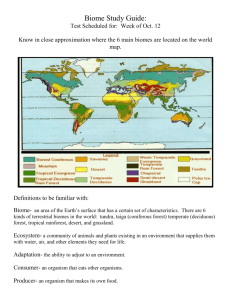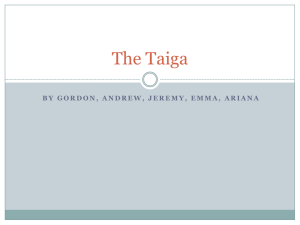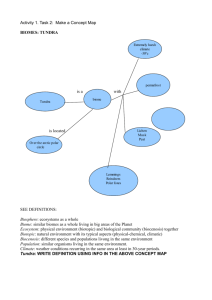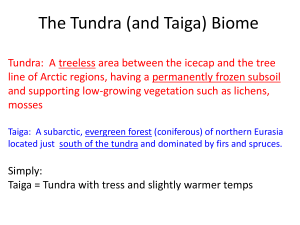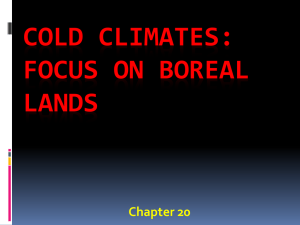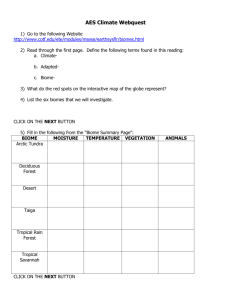Temperature Adaptations of Terrestrial Arthropods of the Yenisey Region of Siberia
advertisement
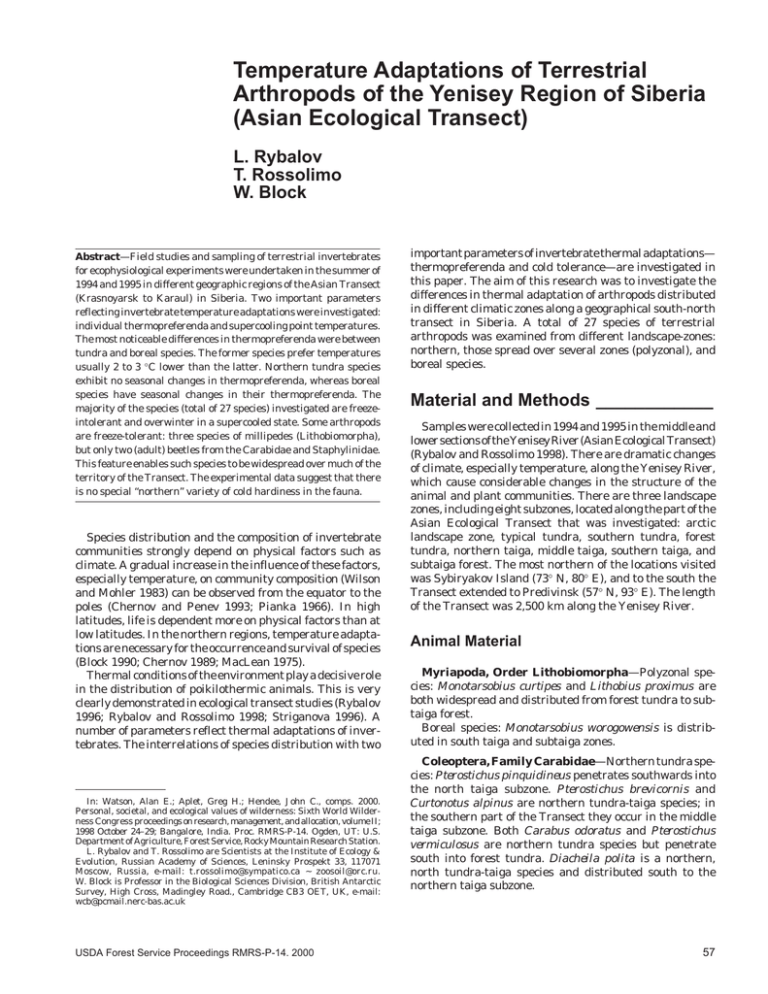
Temperature Adaptations of Terrestrial Arthropods of the Yenisey Region of Siberia (Asian Ecological Transect) L. Rybalov T. Rossolimo W. Block Abstract—Field studies and sampling of terrestrial invertebrates for ecophysiological experiments were undertaken in the summer of 1994 and 1995 in different geographic regions of the Asian Transect (Krasnoyarsk to Karaul) in Siberia. Two important parameters reflecting invertebrate temperature adaptations were investigated: individual thermopreferenda and supercooling point temperatures. The most noticeable differences in thermopreferenda were between tundra and boreal species. The former species prefer temperatures usually 2 to 3 ∞C lower than the latter. Northern tundra species exhibit no seasonal changes in thermopreferenda, whereas boreal species have seasonal changes in their thermopreferenda. The majority of the species (total of 27 species) investigated are freezeintolerant and overwinter in a supercooled state. Some arthropods are freeze-tolerant: three species of millipedes (Lithobiomorpha), but only two (adult) beetles from the Carabidae and Staphylinidae. This feature enables such species to be widespread over much of the territory of the Transect. The experimental data suggest that there is no special “northern” variety of cold hardiness in the fauna. Species distribution and the composition of invertebrate communities strongly depend on physical factors such as climate. A gradual increase in the influence of these factors, especially temperature, on community composition (Wilson and Mohler 1983) can be observed from the equator to the poles (Chernov and Penev 1993; Pianka 1966). In high latitudes, life is dependent more on physical factors than at low latitudes. In the northern regions, temperature adaptations are necessary for the occurrence and survival of species (Block 1990; Chernov 1989; MacLean 1975). Thermal conditions of the environment play a decisive role in the distribution of poikilothermic animals. This is very clearly demonstrated in ecological transect studies (Rybalov 1996; Rybalov and Rossolimo 1998; Striganova 1996). A number of parameters reflect thermal adaptations of invertebrates. The interrelations of species distribution with two In: Watson, Alan E.; Aplet, Greg H.; Hendee, John C., comps. 2000. Personal, societal, and ecological values of wilderness: Sixth World Wilderness Congress proceedings on research, management, and allocation, volume II; 1998 October 24–29; Bangalore, India. Proc. RMRS-P-14. Ogden, UT: U.S. Department of Agriculture, Forest Service, Rocky Mountain Research Station. L. Rybalov and T. Rossolimo are Scientists at the Institute of Ecology & Evolution, Russian Academy of Sciences, Leninsky Prospekt 33, 117071 Moscow, Russia, e-mail: t.rossolimo@sympatico.ca ~ zoosoil@orc.ru. W. Block is Professor in the Biological Sciences Division, British Antarctic Survey, High Cross, Madingley Road., Cambridge CB3 OET, UK, e-mail: wcb@pcmail.nerc-bas.ac.uk USDA Forest Service Proceedings RMRS-P-14. 2000 important parameters of invertebrate thermal adaptations— thermopreferenda and cold tolerance—are investigated in this paper. The aim of this research was to investigate the differences in thermal adaptation of arthropods distributed in different climatic zones along a geographical south-north transect in Siberia. A total of 27 species of terrestrial arthropods was examined from different landscape-zones: northern, those spread over several zones (polyzonal), and boreal species. Material and Methods ____________ Samples were collected in 1994 and 1995 in the middle and lower sections of the Yenisey River (Asian Ecological Transect) (Rybalov and Rossolimo 1998). There are dramatic changes of climate, especially temperature, along the Yenisey River, which cause considerable changes in the structure of the animal and plant communities. There are three landscape zones, including eight subzones, located along the part of the Asian Ecological Transect that was investigated: arctic landscape zone, typical tundra, southern tundra, forest tundra, northern taiga, middle taiga, southern taiga, and subtaiga forest. The most northern of the locations visited was Sybiryakov Island (73∞ N, 80∞ E), and to the south the Transect extended to Predivinsk (57∞ N, 93∞ E). The length of the Transect was 2,500 km along the Yenisey River. Animal Material Myriapoda, Order Lithobiomorpha—Polyzonal species: Monotarsobius curtipes and Lithobius proximus are both widespread and distributed from forest tundra to subtaiga forest. Boreal species: Monotarsobius worogowensis is distributed in south taiga and subtaiga zones. Coleoptera, Family Carabidae—Northern tundra species: Pterostichus pinquidineus penetrates southwards into the north taiga subzone. Pterostichus brevicornis and Curtonotus alpinus are northern tundra-taiga species; in the southern part of the Transect they occur in the middle taiga subzone. Both Carabus odoratus and Pterostichus vermiculosus are northern tundra species but penetrate south into forest tundra. Diacheila polita is a northern, north tundra-taiga species and distributed south to the northern taiga subzone. 57 Polyzonal species: Pterostichus montanus is a widespread species, distributed from typical tundra to subtaiga forests. Notiophilus reitteri is a widespread species distributed from south tundra to subtaiga forests. Boreal species: Pterostichus ehnbergi, Pterostichus dilutipes, and Amara brunnea are widespread species, distributed from forest-tundra to subtaiga forests. Pterostichus drescheri and Carabus aeruginosus are taiga species, found mostly in taiga and subtaiga forests, but penetrating to the north along the intrazonal landscapes. They are rarely found in forest-tundra. Carabus regalis and Calathus micropterus are taiga species, distributed mostly in taiga and subtaiga subzones. Coleoptera, Family Staphylinidae—Northern, tundra species: Atheta sibirica is a northern species found only in the tundra zone. Lathrobium poljarnis is a northern species, occurring in tundra and forest-tundra. Relatively northern species: Mannerheimia arctica occurs in forest-tundra and in northern and middle taiga Atheta (s. str.) graminicola is found in southern tundra and in taiga. Polyzonal species: Liogluta micans is a widespread species; distributed from tundra to subtaiga forest. Boreal species: Oxypoda annularis is found in foresttundra and in all taiga subzones. Quedius jenisseensis and Quedius fuliginosus, and Tachinus rufipes are distributed in taiga and subtaiga forests. Laboratory Procedures Thermopreferenda—Experiments on temperature preference of arthropods were made using a thermal gradient apparatus constructed of plaster with concentric experimental canals (Rossolimo and Rybalov 1979; Tikhomirov and Tikhomirova 1972). The dimensions of the apparatus were 70 x 40 x 7 cm with the canal diameter being 0.5 to 2.0 cm. Insects of different body sizes were examined in canals of corresponding diameter. Temperatures ranged from 6 to 30 ∞C across the apparatus. The relative humidity of air in the apparatus approximated to 100 percent, the atmospheric humidity normally occurring within the soil habitat of such arthropods. This is also the natural humidity for most soildwelling invertebrates. Most of the species examined were predators, and during the experiments individuals were placed in separate canals. At the beginning of the experiment, each specimen was placed in the 16 to 18 ∞C zone and left to explore for 60 to 90 minutes. The temperature was recorded for the zone where the animal stopped and rested. The insect was then disturbed and forced to reselect its preferred temperature. The average number of individuals examined for each species was 10 to 20, giving a total of 120 to 200 observations of temperature preferenda. Supercooling Points—Individual supercooling points (SCPs) were measured with a thermocouple attached to each individual arthropod when cooled, using a micro-refrigera–1 tor with a cooling rate of 1 ∞C min . The SCP was recognized as an exotherm on a trace of the temperature curve shown on a chart recorder (KSP-2). The average number of individuals determined for each species was in the range 20 to 40. Student’s test—Student’s test was used to determine significance in the thermopreferenda and SCP data. 58 Results and Discussion __________ Dramatic changes in climate from south to north along the Asian Ecological Transect produce noticeable differences in landscape and in the distribution of terrestrial invertebrates. Invertebrates are most diverse in the southern part of study in the Transect—throughout the southern taiga and subtaiga subzones. This is particularly so for millipedes, bugs, several beetles in the families Carabidae, Staphylinidae, and Elateridae. It is characteristic for invertebrate species in these zones to have extended ranges in the southnorth meridian direction, which include several landscape zones. Beyond the limits of their main distribution most species are rare and only inhabit intrazonal landscapes. Many typically northern species are found relatively far to the south via intrazonal landscapes; for example, the northern carabids Curtonotus alpinus and Pterostichus brevicornis are recorded in the middle taiga subzone. Similarly, some southern boreal species reach the northern regions by intrazonal landscape habitats. A significant component in the arthropod communities of the Transect comprises polyzonal species with very wide distributions, covering most of the subzones investigated, such as the carabids Pterostichus montanus and Notiophilus reitteri, and the staphylinid Liogluta micans. This correlation of landscape and ecological/zonal distribution of terrestrial and soil-dwelling invertebrates has two main causes: first, the similarity of abiotic conditions, especially soil temperature, when compared with the above ground layers of such ecosystems; and second, the difference in the adaptations of invertebrates to temperature. Comparative Analysis of Thermopreferenda It is necessary to use experimental techniques to investigate the thermal adaptations of terrestrial invertebrates, especially arthropods. A considerable amount of experimental data on thermopreferenda of different invertebrate taxa, mostly from temperate regions, has been accumulated. Recent studies devoted to thermopreferenda of arctic and subarctic species include Babenko (1993) and Rossolimo and Rybalov (1994). Myriapoda, Order Lithobiomorpha—Thermopreferenda of three species were investigated: Monotarsobius curtipes, Lithobius proximus, and Monotarsobius worogowensis. The most numerous species, M. curtipes, from forest tundra and middle taiga areas was examined in detail. Individuals from the forest tundra population had a wide range of temperature preferences from 14 to 25 ∞C, the majority being in the range 17 to 22 ∞C in summer. The mean thermopreferendum was 18.2 ∞C. In autumn animals, the thermopreferenda were similar: 13 to 25 ∞C and 16 to 21 ∞C, respectively; the mean being 17.9 ∞C. Individuals of the taiga population had thermopreferenda of 16 to 26 ∞C (July) and 15 to 25 ∞C (September). In both summer and autumn, the most preferred temperature was between 18 and 22 ∞C. Lithobius proximus thermal preferences were very similar to M. curtipes. This species had a wide range of temperature (12 to 24 ∞C), and thermopreferenda (18 to 22 ∞C). There were no seasonal dynamics in its thermopreferenda. USDA Forest Service Proceedings RMRS-P-14. 2000 In summer and autumn, Monotarsobius worogowensis preferred higher temperatures than the two previous species; in summer it was 16 to 27 ∞C, and the most preferred temperature was in the range from 18 to 24 ∞C. The mean thermopreferendum was 19.6 ∞C and there were no seasonal changes in thermopreferenda. The three species of Lithobiomorpha studied had thermopreferenda corresponding to their distribution in landscape zones. Boreal species such as M. worogowensis chose higher temperatures (by 2 to 2.5 ∞C) than the other two widespread species. None of the three species showed seasonal changes in their thermopreferenda. Coleoptera, Family Carabidae—Most of the carabids could be combined into three groups (see Material and Methods section). The first group includes northern, mostly tundra, species. The second, more numerous group, comprises boreal species, while the third, and not so abundant, group contains polyzonal species with wide distributions along the Transect. Pterostichus pinquidineus individuals collected from the western part of the Taimir Peninsula demonstrated summer thermopreferenda from 13 to 22 ∞C with a mean value for July and August of 16.2 ∞C. More often, individuals preferred temperatures from 15 to 18 ∞C (zone of most preferable temperatures). In autumn, the thermoprefenda and the zone of most preferred temperatures were similar, but slightly lower—from 12 to 21 ∞C and 14 to 17 ∞C, respectively. The mean thermopreferendum was also slightly lower in autumn at 15.6 ∞C. However, statistical comparison of summer and autumn thermopreferenda showed no significant difference (P >0.05). Thermopreferenda were examined in Curtonotus alpinus individuals collected from two areas of the western Taimyr Peninsula in typical southern tundra, and they ranged from 13 to 24 ∞C. In summer, individuals chose temperatures mostly from 16 to 20 ∞C (mean 17.4 ∞C). In autumn, both of these parameters remained unchanged: 13 to 23 ∞C for thermopreferenda and 16 to 19 ∞C for the zone of most preferred temperatures. The mean thermopreferendum in September was 17.8 ∞C, which is close to that in summer. There was no statistical difference between summer and autumn thermopreferenda (P >0.05). This typical northern tundra carabid is relatively stable in its seasonal thermal requirements. There were significant differences between thermopreferenda of northern tundra species (such as Curtonotus alpinus, Pterostichus brevicornis, and Pterostichus pinquidineus) and boreal species (such as Pterostichus dilutipes, Carabus regalis, and Calathus micropterus). The former had mean thermopreferenda and a most preferred temperature zone (14 to 18 ∞C) usually about 2 to 3 degrees lower than the latter (17 to 23 ∞C). In summer, tundra species exhibited a wider temperature zone than boreal species. Polyzonal species such as Pterostichus montanus and Notiophilus reitteri usually choose a wide temperature zone (13 to 25 ∞C) with no distinct area of most preferable temperatures. The 15 carabid species examined had different seasonal changes in their thermopreferenda and may be combined into four groups with similar seasonal temperature choices. The first group contains species without strong seasonal dynamics in their thermopreferenda; these are typical USDA Forest Service Proceedings RMRS-P-14. 2000 northern tundra taxa—Pterostichus pinquidineus and Pterostichus brevicornis. The second group comprise species with seasonal changes in thermopreferenda—choosing the lower temperatures in autumn than in summer—Pterostichus ehnbergi, P. dilutipes, P. drescheri, Carabus aeruginosus, and C. regalis. There were significant differences between summer and autumn thermopreferenda (P <0.05 or P <0.01). Amara brunnea belongs to the third group, which had a statistically significant increase in its mean thermopreferendum in autumn compared with summer by 3 to 6 ∞C (P <0.01). Species in the fourth group have two preferable temperature zones in autumn; one encompasses the same temperatures as in summer while the second has lower preferable temperatures than in summer. This was noted for the boreal carabid Calathus micropterus and the polyzonal Notiophilus reitteri. These bimodal thermopreferenda may be explained by the physiological differences between individuals in the population in autumn during preparation for overwintering. The species of Carabidae examined showed a broad correlation of landscape zone distribution with their thermopreferenda and the seasonal changes. Coleoptera, Family Staphylinidae—Analysis of experimental data on the thermopreferenda of 6 species of staphylinid beetles demonstrated similar tendencies to the Carabidae examined. In the northern species Lathrobium poljarnis, the area of preferable temperatures is 2 to 4 ∞C lower in comparison with those of boreal species. The thermopreferendum of L. poljarnis is 13 to 18 ∞C, mean value is 16.5 ∞C (boreal species lie in the range 16 to 21 ∞C). Species distributed in the taiga region but also found in more northern areas, such as Liogluta micans and Oxypoda annularis, choose intermediate temperatures (14 to 19 ∞C) between the thermopreferenda of tundra species such as Lathrobium poljarnis and boreal species such as Quedius jenisseensis and Tachinus rufipes. The seasonal changes in thermopreferenda of the Staphylinidae were similar to those of the Carabidae. In the former are species without seasonal dynamics in thermopreferenda: the northern species Lathrobium poljarnis and the boreal species Liogluta micans, which penetrates into the northern regions. In the latter are Oxypoda annularis and Tachinus rufipes—both exhibiting statistically significant decreases in mean thermopreferenda of 2 to 3 ∞C in autumn. Species belonging to a third group (Quedius fuliginosus and Quedius jenisseensis) have statistically significantly higher thermopreferenda in autumn than in summer (by 2 to 2.5 ∞C). Comparative Analysis of Cold Resistance Adaptations to low winter environmental temperatures are important for the survival of many terrestrial invertebrates. Avoidance of damage by cold in invertebrates living in low temperature habitats is achieved by two main physiological mechanisms: by avoiding freezing through supercooling (maintenance of their body fluids in the liquid phase below the normal freezing temperature) and by tolerance to extracellular freezing (freeze-tolerant) (Salt 1961). The former species are termed freeze-intolerant (Block 1982a). Arthropods employ both strategies and in some species both occur, but in different life stages. Switching from one to the 59 other strategy has been reported in a coleopteran species by Horwath and Duman (1984). The mechanisms underlying both strategies depend on signals from the surrounding environment (Bale 1989). Because of the widespread occurrence of the freeze-avoiding strategy in arthropods (Block 1982a, 1990), the supercooling ability was used as a convenient index for comparison of cold resistance in samples collected from the Transect. This involved the measurement of individual supercooling (freezing) point temperatures (SCP; see Methods section) and assessment of their subsequent survival. Some cold-hardiness data for sub-Arctic Coleoptera have been reported by Rossolimo (1994). Myriapoda, Order Lithobiomorpha—All species of Lithobiomorpha examined were freeze-tolerant and overwinter in a frozen state. Three species of millipede show similar SCPs and seasonal changes. The mean SCP of Monotarsobius curtipes individuals collected in forest tundra in July was –4.5 ∞C, in September it was –3.9 ∞C, and in February it was –3.1 ∞C. The mean SCP of individuals collected from the middle taiga zone in July was –4.9 ∞C, in September it was –3.2 ∞C, and in February it was –3.1 ∞C. Because this species overwinters in a frozen state, this may explain the very small seasonal changes in supercooling ability due to their particular nucleators remaining active all year round. Relatively high freezing temperatures are common in animals surviving at subzero temperatures with extracellular ice in their bodies. Coleoptera, Family Carabidae—Ground beetles may be placed in three categories based on the SCP data. The first category comprises the northern species Pterostichus brevicornis, P.vermiculosus, P. pinquidineus, Diacheila polita, and Carabus odoratus. A further species belongs to this category—P. montanus—which is widespread and penetrates north along the Transect. The cold resistance (supercooling ability) of these species remains unchanged with the seasons. All the ground beetles examined were freeze-intolerant. These species either overwinter in a supercooled condition or in some cases the adult instar does not overwinter. The second category includes boreal species with their main distribution in the taiga and subtaiga zones. Mean SCPs of these beetles decreased by 2 to 4 ∞C during winter. The differences between mean SCPs in summer and autumn were statistically significant (P <0.05). All the beetles examined were freeze-intolerant. These species probably overwinter in the supercooled state. Carabus aeruginosus, C. regalis, Pterostichus drescheri, P. ehnbergi, P.dilutipes, Amara brunnea, Calathus micropterus, and Notiophilus reitteri belong to this category. Most of these species reproduce in the autumn. It is known that a large volume of fat body and gonads increase cold resistance (Storey and Storey 1989). In the third group, there is the northern tundra species Curtonotus alpinus. Beetles collected in different tundra subzones and in forest tundra in summer had low SCP temperatures of –5.5 to –5.6 ∞C. In autumn, the mean SCP was slightly higher than in summer, by about 1.0 to 1.5 ∞C, but these differences were not statistically significant (P >0.05). C. alpinus is the only species of ground beetle studied that is freeze-tolerant. Although C. alpinus is mixophagous, it is more prone to phytophagy, which may increase its tolerance to freezing (Block 1982b). 60 Coleoptera, Family Staphylinidae—The supercooling ability of nine species of staphylinids was measured. These species inhabit different landscape zones and subzones from typical tundra to subtaiga forest. All the staphylinids had relatively low SCPs in summer and ranged from –4.5 to –6.8 ∞C. In typical boreal species, such as Quedius fuliginosus and Tachinus rufipes, mean SCPs in summer were higher (–3.5, –4.5 ∞C) than those of northern and polyzonal species (–5.0, –6.5 ∞C). The main differences between northern species of the Staphylinidae and the more southern boreal species is in the type of seasonal fluctuations in supercooling ability. In the boreal Quedius jenisseensis, Quedius fuliginosus, Tachinus rufipes, Oxypoda annularis, and the widespread Liogluta micans, a distinct seasonal change in SCP was observed. Autumn values were 2 to 4 ∞C lower than in summer (P <0.05). All these species are active in summer and autumn. In relatively northern species, such as Atheta sibirica, Mannerheimia arctica, and Atheta. (s. str.) graminicola, seasonal changes of SCP were not recorded. SCP values were rather low, even in summer (–6.2, –6.5 ∞C). These species probably overwinter in the supercooled condition. Only one specifically northern tundra staphylinid, Lathrobium poljarnis, was freeze-tolerant. As in the northern group of species, seasonal SCP dynamics were absent. Summer and autumn mean SCPs were relatively high: –4.8 and –4.6 ∞C, respectively. Conclusions ____________________ Experimental data for arthropods demonstrate connections between the seasonal dynamics of their observed thermopreferenda and their distribution in habitats of the various landscape zones of the Transect. Species with a northern distribution have mean thermopreferenda and their main preferable temperature zone 2 to 3 ∞C lower than those of boreal species. Also, tundra species have a wider range of preferable temperatures than boreal taxa. The thermal requirements of many of the species appear to be stable and do not change greatly over their entire distribution along the Transect. “Southern” boreal species, which prefer relatively high temperatures in the experiments, penetrate into the northern subarctic and arctic regions only via intrazonal boreal sites where the soil and surface litter are protected in winter by a deep snow layer. A single important parameter reflecting the thermal needs of such arthropods is the seasonal fluctuations in their thermopreferenda. Northern tundra species, for example Pterostichus pinguidineus, Curtonotus alpinus, and Lathrobium poljarnis, do not exhibit significant seasonal changes in their thermopreferenda. Boreal species have two types of seasonal thermopreferenda connected with the timing of their activity during the year and physiological preparations for overwintering. Most boreal species prefer lower temperatures in autumn than in summer. For example, individuals of Pterostichus ehnbergi, Carabus aeruginosus, Oxypoda annularis, and Tachinus rufipes choose lower temperatures in autumn than in summer. However, several other species display an opposite tendency; individuals of Amara brunnea and Quedius jenisseensis preferred higher temperatures in autumn than in summer. USDA Forest Service Proceedings RMRS-P-14. 2000 The supercooling abilities of adult beetles remain much the same throughout the area of a species distribution. Seasonal fluctuations in mean SCPs also appear to be species specific. The species of millipedes examined were all freeze-tolerant with no zonal differences in SCP. Most of the Coleoptera studied were freeze-intolerant and overwintered in the supercooled state. Only two species of Coleoptera were freeze-tolerant: Curtonotus alpinus (Carabidae) and Lathrobium poljarnis (Staphylinidae), both distributed throughout the tundra area of the Transect. Seasonal changes in mean SCPs of northern-distributed Coleoptera differed from those of boreal taxa. The boreal Carabus aeruginosus, Pterostichus ehnbergi, and Quedius jenisseensis show seasonal fluctuations in SCPs. In autumn, their SCPs are 2 to 4 ∞C lower than in summer. More northern species (Pterostichus brevicornis, Carabus odoratus, Atheta sibirica, and Mannerheimia arctica) have no seasonal changes in their SCPs. These results suggest that there are no significant alterations in cold hardiness with the different climatic regimes along the Transect and that there is no special “northern” variety of cold hardiness in the species examined. Such data support the hypothesis of the importance of pre-adaptations in the survival strategies of such terrestrial arthropods in the Arctic environment. References _____________________ Babenko, A. B. 1993. Thermopreferenda of Collembola from the Arctic tundra of Taimir. Zoologicheskyi zhurnal. 72(4): 41-52. Bale, J. S. 1989. Cold hardiness and overwintering of insects. Agricultural Zoological Reviews. 3: 157-192. Block, W. 1982a. Cold hardiness in invertebrate poikiloterms. Comparative Biochemistry & Physiology. 73a: 581-593. Block, W. 1982b. Supercooling points of insects and mites on the Antarctic Peninsula. Ecological Entomology. 7: 1-8. Block, W. 1990. Cold tolerance of insects and other arthropods. Philosophical transactions of the Royal Society of London. (B) 326: 613-633. USDA Forest Service Proceedings RMRS-P-14. 2000 Chernov, Yu. I. 1989. Temperature conditions and Arctic biota. Ecologia (Sverdlovsk). 2: 49-57. Chernov, Yu. I.; Penev, L. D. 1993. Biological diversity and climate. Uspehi sovremennoi biologii. 113(5): 515-531. Horwath, K. L.; Duman, J. G. 1984. Yearly variations in the overwintering mechanisms of the cold-hardy beetle Dendroides canadensis. Physiological Zoology. 57: 40-45. MacLean, S. F. 1975. Ecological adaptations of tundra invertebrates. In: Physiological adaptation to the environment. New York: Index Educational Publications. 269-300. Pianka, E. P. 1966. Latitudinal gradients in species diversity. A review of concepts. American Naturalist. 100: 33-46. Rossolimo, T. E. 1994. Comparative analysis of Subarctic Coleoptera cold hardiness. Zoologicheskyi zhurnal. 73(7-8): 101-113. Rossolimo, T. E.; Rybalov, L. B. 1979. Thermo- and hygropreferenda of several invertebrate species in connection with landscape distribution. Zoologicheskyi zhurnal. 58(12): 1802-1810. Rossolimo T. E.; Rybalov, L. B. 1994. Thermopreferenda of Coleoptera from the Arctic region. Zoologicheskyi zhurnal. 73(9): 54-64. Rybalov, L. B. 1996. Zonal and landscape changes of populations of soil macrofauna along an Asian ecological transect. In: Soil organisms and soil resource management: XII International colloquium on soil zoology; 1996; Dublin, Ireland. 90. Rybalov, L. B.; Rossolimo, T. E. 1998. Asian ecological transect: evaluation of biodiversity of soil animal communities in the Central Siberia. In: Watson, Alan E.; Aplet, Greg H.; Hendee, John C., comps. 1998. Personal, societal, and ecological values of wilderness: Sixth World Wilderness Congress proceedings on research, management, and allocation, volume I; 1997 October; Bangalore, India. Proc. RMRS-P-4. Ogden, UT: U.S. Department of Agriculture, Forest Service, Rocky Mountain Research Station. 49-54. Salt, R. W. 1961. Principles of insect cold-hardiness. Annual Review of Entomology. 6: 55-74. Storey, K. B.; Storey, J. M. 1989. Freeze tolerance and freeze avoidance in ectotherms. In: Wang, L. C. H., ed. Advances in comparative and environmental physiology. Berlin: SpringerVerlag. Vol 4: 51-82. Striganova, B. 1996. Transect approach to the assessment of soil macrofauna diversity. Biology International. 33: 17-23. Tikhomirov, S. I.; Tikhomirova, A. L. 1972. Method of investigations on thermopreferendum of litter dwelling arthropods. Ecologia (Sverdlovsk). 4: 70-77. Wilson, E. O.; Mohler, C. L. 1983. Measuring composition change along gradients. Vegetatio. 54: 129-141. 61
